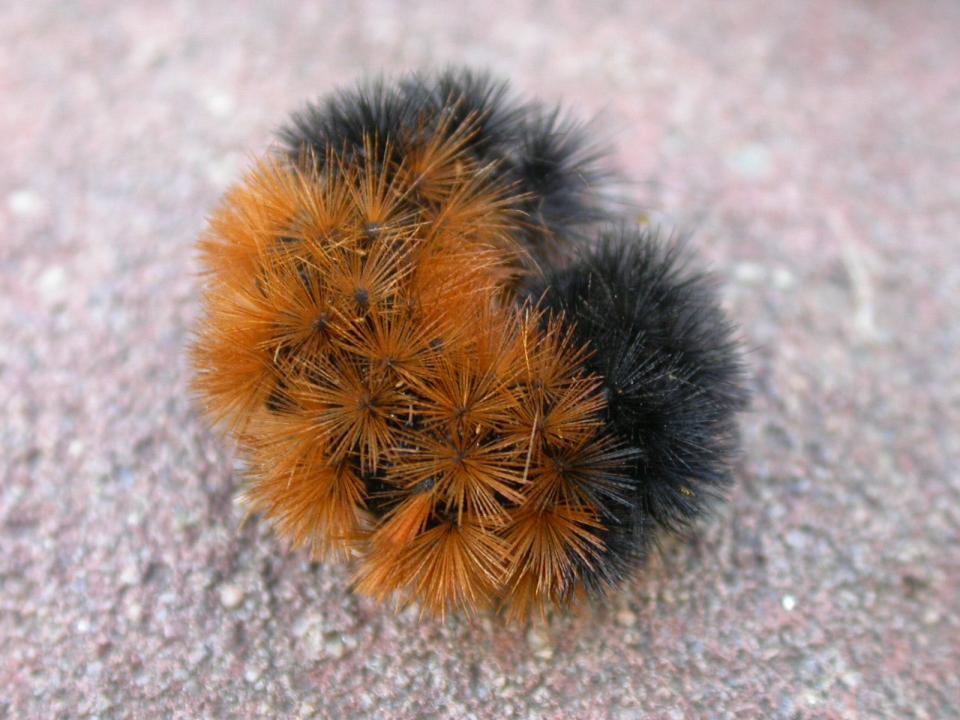Woolly weather predictions: Entomologist weighs in on caterpillar folklore
Editor's note: This story was originally published in 2021. We are resurfacing it as part of our fall coverage.
Everyone in the Midwest has seen them. Woolly bears, the little black and brown furry caterpillars that inch their way across sidewalks, are a common sight in September.
They go by many names: woolly worms, fuzzy bears, hedgehog caterpillar for the way they curl up for safety. If you're a stickler for science: Pyrrharctia isabella.
Some people stop to help them cross busy pathways and others inspect them for signs of the impending winter. Not many people, however, know why the fuzzy larvae are around or if their stripes really hold any weather predicting clues.
'Most expensive crop in decades':Farmers face higher stakes than ever with inflation
There are several different species of woolly bears, varying in colors, but all of them become variations of the tiger moth. Although many people notice woolly bear caterpillars because of their furry appearance, tiger moths are fairly plain looking and are one of the species seen fluttering around porch lights in the summer.
The caterpillars are born in two generations, one in late spring and the other in late summer, and feed on tall weeds, shrubs and small trees. They are not known as pests.
Let's talk about the winter folklore around woolly bears
As with most folklore, there are several variations. The National Weather Service explains:
1. The amount of black on the caterpillar in autumn indicates the severity of weather in the area where it's found. More black equals longer, colder, snowier. Less black equals milder winter weather.
2. The location of the black bands is said to predict which part of winter will be worse. If the head of the caterpillar is dark, winter will start cold. If the tail is dark, the end of winter will be worse.
3. There's also the coat itself. If the woolly bear is extra woolly, it will be a cold winter. Slim coat means a milder winter.
4. Direction of travel is also a supposed winter weather indicator. See one inching south, it's fleeing northern winter. Heading north, then it's all good winter-wise because they're willing to stick around.
Fall leaves:Where and when fall foliage will peak in Indiana
But what's really going on with these cute critters?
Purdue entomology professor Timothy Gibb said besides entomologists, people don't notice woolly bears until September. Then, they're everywhere.
"They migrate from the plants that they've been feeding on and for some inexplicable reason, they decide they've got to move," Gibb said. "I can park on the road and see one going one direction and another going the other direction, and they're just bootin' along. They don't even stop to say hi to each other. They're on a race to somewhere, but nobody knows where."
Despite the randomness of the caterpillars' travels, Gibbs said it's safe to assume they're looking for a place to stay the winter.
Indiana winter forecast:Farmer's Almanac makes some seriously chilling predictions for coming winter
Woolly bears make ethylene glycol. Wait, what?
Woolly bears handle winters differently than most caterpillars. Instead of spending the cold days snug in a cocoon, they curl up under leaves or logs and their bodies produce ethylene glycol, the same substance in antifreeze for cars. The ethylene glycol lowers the caterpillars' blood freezing point and allows them to survive the winter.
Their ability to survive the winter leads to the folklore surrounding the brown and black species of woolly bears.
So, what about those stripes?
Stories about the woolly bear's ability to drop some prophetic winter knowledge mostly seem to center on the caterpillars' stripes, as noted above from the National Weather Service.
Prediction vs reality: How Old Farmer's Almanac predictions have compared to actual Indianapolis winters
Gibbs said just based on the unscientific nature of measuring the stripes alone, the folklore isn't true. But he isn't against it either.
"I'm kind of in favor of having some folklore; it's fun," Gibb said. "But on the same token, there's not a chance that these are smart enough to predict the weather. We have meteorologists that are employed, that go to school a long time and still can't predict the weather, how do you expect this little insect to do it?"

Gibb said while it may be possible the hair on the caterpillars' bodies also plays a role in keeping them warm, there isn't any scientific evidence of it. Woolly bears' natural antifreeze and their instinct to burrow under leaves and other organic debris are their real survival tools. Gibb, who has horses, said he sees the woolly bears asleep during the winter months under hay in his barn.
Can woolly bears sting or poison you?
Woolly bears can be irresistible to touch, especially for children, and Gibb said although some fuzzy caterpillars have stinging hairs that are poisonous, black and brown woolly bears are not toxic and can be touched without fear.
Contact Pulliam Fellow Lilly St. Angelo at lstangelo@gannett.com. Follow her on Twitter: @lilly_st_ang
This article originally appeared on Indianapolis Star: Woolly bear: A look at weather folklore, other facts

